With easy access to a high-quality camera on smartphones, it's no surprise photography has exploded as a hobby. If you love sharing photos with family and friends and have already mastered the art of the selfie, it might be time to elevate your photography abilities. Luckily, mastering essential photography concepts doesn't require expensive schooling—by learning basic skills and practicing your craft, you can capture stunning, professional-looking photographs.
Why start learning about photography?
Before you begin snapping photographs, get organized. First, consider the goals of your newfound hobby. The reasons behind reaching for the camera differ from person to person. Mastering basic photography concepts lets you effectively promote yourself on social media or take professional-looking photos for your small business. You might be looking for a new side hustle, or maybe you just want to beautifully capture important family memories. Your personal photography goals will determine the best methods for learning photography and the type of equipment you should invest in.
What you need to get started
When you first begin learning photography, you don't need to purchase a lot of expensive equipment. Practicing using what you have or purchasing used cameras can help you master the basics. Once you've gained confidence behind the lens, investing in your equipment upgrades the quality and craftsmanship of your images. Consider these common photography equipment options to complete your photography setup.
- Camera and camera bag
- Tripod
- Lenses and filters
- Memory cards
- Extra batteries
If you already own basic equipment, start saving money toward a higher-quality camera or invest in a new wide-angle lens.
How to become a photographer without going to school
You won't need to get a degree in photography or attend expensive classes to learn photography as a hobbyist. Following these basic photography tips will help you improve your skills on your own.
Study your equipment
Although you probably already know how to snap a simple picture with your camera, learning about your equipment saves you time in the long run. Most cameras have default auto settings but understanding manual settings and when to use them will take your photographs to the next level. Learn about your camera's settings and your other photography equipment by studying any included instructional manuals. You can also find information on the brand's website or by watching online video tutorials.

Learn basic camera terminology
It's much easier to improve the quality of your photographs if you understand basic camera terminology. When you first buy your camera, you'll probably receive a standard lens with a focal length between 35mm and 50mm. Learn what focal lengths are best for the images you want to take. For subjects in the distance, a telephoto lens with a 200mm focal length gives the best results. Focal lengths also affect the width of your image—try a 24mm focal length for a wide-angle photograph.
Exposure, the amount of light that reaches your camera's sensor, determines the brightness of your final image. Most modern cameras make adjusting exposure easy—use the automatic mode to automatically adjust exposure settings or learn these terms to unlock the full potential of your camera.
Aperture: Like exposure, controlling the aperture affects the amount of light that passes through the lens of your camera. A higher aperture creates a larger opening for more light to pass through, while a lower aperture narrows the opening. Aperture also changes the depth of field, making objects in the background of your photo appear blurred.
Shutter speed: The speed at which the shutter of your camera closes controls how long the light coming in through your lens exposes the camera sensor. The longer the exposure, the brighter your photo will be. If the shutter speed is too high, your image may turn out too dark.
ISO: ISO refers to your camera's sensitivity to light. A lower ISO makes your camera's sensor less sensitive to light, while a higher ISO makes it more sensitive. On a bright and sunny day, use a low ISO. In low light situations, try a higher ISO to boost your camera sensor sensitivity.
Experiment with composition
Composition refers to the arrangement of objects in the frame of your image. By experimenting with different angles and placements, you'll be able to see what looks the most appealing to the eye.
Consider what you want to convey with your photographs and what objects or subjects are key to that meaning. Based on the composition of your image, you'll be able to subtly determine the visual path of your viewers' eyes. Photographers often follow the rule of thirds, placing their subject in the right or left third of an image, for a more engaging composition.

If you want to start learning photography concepts even before you purchase a camera, play around with photo composition by taking photos with your smartphone.
Watch online tutorials
For professional-looking images, you may not be able to learn some photography concepts entirely on your own. Online tutorials are an inexpensive or free alternative to formal photography education. From learning how to use your camera's settings effectively to gaining editing skills, tutorials cover a broad range of photography concepts for hobbyists.
Define your personal style
Different styles and types of photography require a variety of skillsets. It's perfectly normal to not know your personal style when you first start, but you should consider what you're most drawn to. The type of photography you pursue will determine the equipment you need and the skills you should hone. If you primarily take photos of family members or friends, portrait photography involves specific equipment, like additional lighting sources or tripods. Some types of photography, like wildlife photography, require specific lenses that accommodate taking photos from a distance.
Practice makes perfect
Whether you go to school or study on your own, the most important step to learning photography is taking photographs. Practicing regularly improves the quality of your photographs more than anything else. As you continue to take photographs, evaluate each one you take and consider what aspects of the image you like. Incorporate what you learn into the next photograph you take.

Hone your editing skills
The process of taking an engaging and professional photograph doesn't end after clicking the shutter-release button. Learning basic editing skills using free or affordable editing tools will take your photographs to the next level. When you export your images from your camera, take note of JPEG and RAW options. RAW files allow you to edit the highest quality images, but JPEG files take up less storage and don't require conversion before sharing them. Using online cloud storage for your files can give you the space you need to edit the best possible images.
Learning the basics of photography doesn't require formal education—anyone with a camera can start practicing and refining their photography skills. Once you understand the basics of your equipment and follow simple best practices, you'll be able to pick up your camera and start shooting stunning photographs.
Share your photos
The best way to celebrate your new photography skills is to share your photos with others. Microsoft Create offers thousands of professionally designed templates and you can easily swap your photographs in to showcase them even more beautifully.
If you’ve decided to turn your passion for photography into a business, we've got help for that too, with templates built with your business in mind. From business planning to marketing assets and social media posts, you can find inspired designs that are customizable in just a few moments.





